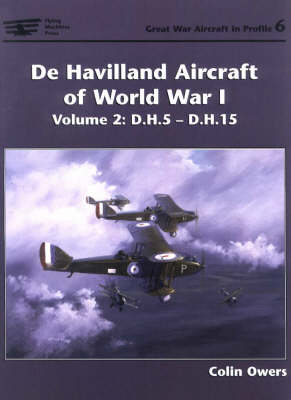Flying Machines Press
2 total works
The Aircraft Manufacturing Company - Airco - was established at The Hyde in Hendon, north London, England during 1912 by George Thomas. Geoffrey de Havilland joined two years later as the chief designer, on leaving his post with the Royal Aircraft Factory. His designs for Airco were marked with his initials "DH". The first great success was a pusher engine fighter DH.2 of 1916, that helped to defeat the "Fokker scourge" of 1915. More than 2,280 examples of the DH.6 trainer were built. The DH.4 and DH.9 were important light bombers of World War I - these types, and the DH.9A, a developed version that served for many years with the postwar Royal Air Force, formed the basis of early de Havilland designed airliners - including the company's DH.16 and DH.18 types which were operated by Aircraft Transport and Travel Limited, the first airline established in the United Kingdom, that was also owned by George Holt Thomas.
Following the cessation of hostilities the company's undue reliance on military orders became a handicap however and the company became bankrupt in 1920. Its assets were bought by the Birmingham Small Arms Company which did not pursue aviation-related business. The aviation related assets of the company were bought by Geoffrey de Havilland and he formed the de Havilland Aircraft Company in 1920.
Noted military aviation expert Colin Owers presents the most comprehensive work ever compiled on the great de Havilland aircraft of World War I.
The second volume in this series contains the most complete story of the little-known D.H.6, plus much new information on the rest of the de Havilland aircraft line. More than 140 photos, all-new drawings and 8 x 12-inch fold-outs, and 40 four-color profiles, including the first drawings of the D.H.11, round out this definitive book.
Following the cessation of hostilities the company's undue reliance on military orders became a handicap however and the company became bankrupt in 1920. Its assets were bought by the Birmingham Small Arms Company which did not pursue aviation-related business. The aviation related assets of the company were bought by Geoffrey de Havilland and he formed the de Havilland Aircraft Company in 1920.
Noted military aviation expert Colin Owers presents the most comprehensive work ever compiled on the great de Havilland aircraft of World War I.
The second volume in this series contains the most complete story of the little-known D.H.6, plus much new information on the rest of the de Havilland aircraft line. More than 140 photos, all-new drawings and 8 x 12-inch fold-outs, and 40 four-color profiles, including the first drawings of the D.H.11, round out this definitive book.
The Aircraft Manufacturing Company - Airco - was established at The Hyde in Hendon, north London, England during 1912 by George Thomas. Geoffrey de Havilland joined two years later as the chief designer, on leaving his post with the Royal Aircraft Factory. His designs for Airco were marked with his initials "DH". The first great success was a pusher engine fighter DH.2 of 1916, that helped to defeat the "Fokker scourge" of 1915. More than 2,280 examples of the DH.6 trainer were built. The DH.4 and DH.9 were important light bombers of World War I - these types, and the DH.9A, a developed version that served for many years with the postwar Royal Air Force, formed the basis of early de Havilland designed airliners - including the company's DH.16 and DH.18 types which were operated by Aircraft Transport and Travel Limited, the first airline established in the United Kingdom, that was also owned by George Holt Thomas.
Following the cessation of hostilities the company's undue reliance on military orders became a handicap however and the company became bankrupt in 1920. Its assets were bought by the Birmingham Small Arms Company which did not pursue aviation-related business. The aviation related assets of the company were bought by Geoffrey de Havilland and he formed the de Havilland Aircraft Company in 1920.
Noted military aviation expert Colin Owers presents the most comprehensive work ever compiled on the great de Havilland aircraft of World War I.
Volume I in this two-book set contains groundbreaking information on the D.H.1 and D.H.1A, D.H.2, D.H.3, D.H.4 and the U.S. D.H.4"Liberty Plane." Among the 160 rare photos, detailed drawings (including 8 pages of 8 x 12-inch fold-outs) and 40 lavish full-color illustrations are first drawings ever of the D.H.3.
Following the cessation of hostilities the company's undue reliance on military orders became a handicap however and the company became bankrupt in 1920. Its assets were bought by the Birmingham Small Arms Company which did not pursue aviation-related business. The aviation related assets of the company were bought by Geoffrey de Havilland and he formed the de Havilland Aircraft Company in 1920.
Noted military aviation expert Colin Owers presents the most comprehensive work ever compiled on the great de Havilland aircraft of World War I.
Volume I in this two-book set contains groundbreaking information on the D.H.1 and D.H.1A, D.H.2, D.H.3, D.H.4 and the U.S. D.H.4"Liberty Plane." Among the 160 rare photos, detailed drawings (including 8 pages of 8 x 12-inch fold-outs) and 40 lavish full-color illustrations are first drawings ever of the D.H.3.

